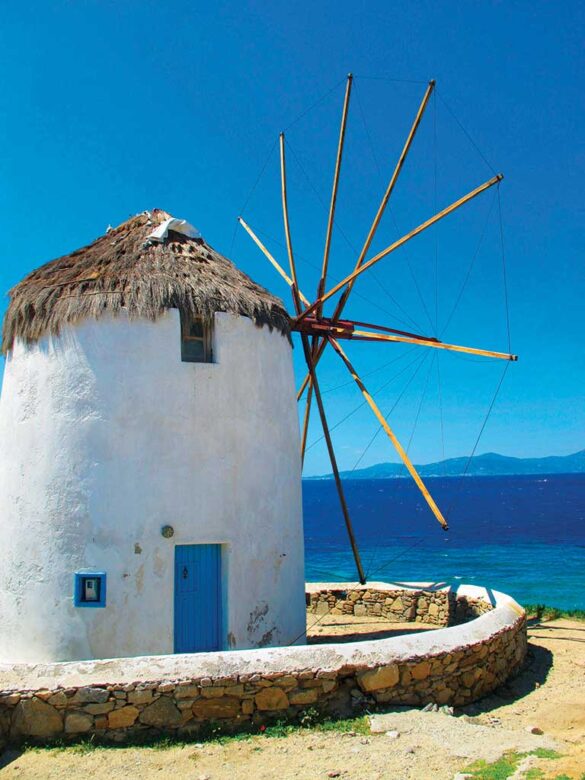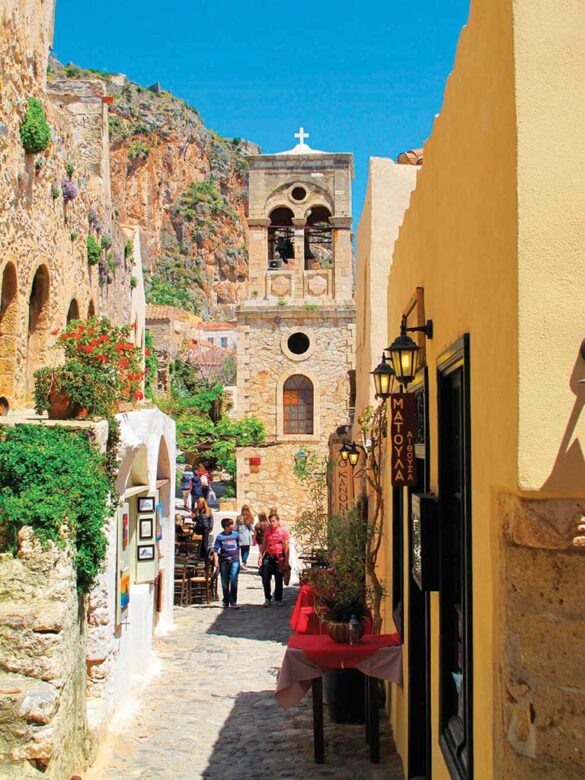After a full day at sea and we dock in Motril, Spain; little of interest here except as the gateway to the crown jewel of Andalusia, the Alhambra. In the eighth century the Moors swept across to Spain and were only driven out in 1492. In the intervening centuries they brought a high level of civilization to Spain, and the Alhambra represents the zenith of Moorish culture and style.
Constructed on a plateau overlooking Granada, with the snow-capped peaks of the Sierra Nevada as back drop, Alhambra began in 889 C.E. as a fortress spread over two hills divided by a valley, later converted into a palace by the Nasrid rulers, then occupied by Christian Kings, it is now a UNESCO World Heritage Site.
The Moorish portion of the Alhambra includes the Alcazaba, or citadel, which is the oldest section—only its massive outer walls, towers, and ramparts remain. The Alhambra has been damaged and restored over the centuries, but it’s not difficult to picture it as it was in its glory 600 years ago. The principal courtyards of the palace are the Court of the Myrtles and the Court of the Lions, named for the 12 marble lions supporting an alabaster basin. Grand rooms open onto the courtyard, and the Hall of Two Sister is an outstanding example of Moorish stalactite work. The less opulent, but still lovely, daily living quarters are centered in the Generalife, with terraced gardens, pools, and endless fountains creating an enchanting atmosphere.
Back on the ship, every evening before dinner in the cozy library with faux fireplace, shelves of books in several languages, and board games, Peter Kissner with perennial tan and sun-bleached locks, holds a talk about such topics as the history of clipper ships, ancient and modern piracy, star navigation, sailing in the ancient world, etc. Peter has a wealth of knowledge and fascinating stories. The voyage would have been far less meaningful without the information he imparted. From Peter, we also learn that the Star Clipper occasionally hosts gay cruises, nude cruises, and gay-nude cruises; in this chilly weather, I shiver at the thought.

Windmill in Mykonos Greece
The Star Clipper’s dining room, fitted with cushioned booths and tables for eight, serves as grand central three times daily. Attire is decidedly casual, though men typically don button shirts and trousers and women dress up for dinner. Several starter options such as eggplant quiche, shrimp and vegetable tempura, and hearts of palm salad are offered. Entrée choices always include a vegetarian option. Breakfast, my favorite, is a buffet offering fruit, yogurt, cheeses, freshly baked pastries and breads, and an omelet station. Lunch is also a buffet with a half dozen warm dishes, fresh makings for a delicious salad, and three or four desserts.
An addendum to the Bern story. We wonder why no bananas are to be found on board. It turns out that since the 1700s, the tropical fruit is a seafaring no-no since, so fraught with superstition that it’s an omen for disaster. One theory is that bananas aboard slave ships fermented and emitted methane gas, killing everyone in the hold; another is that crewmen died of bites from a poisonous spider hiding in bunches. I posit to Bern that per- haps his almost-missing-the-ship mishap was caused by his fruit purchase in Tangier. He isn’t buying it, but later a bag with the remaining fruits are hanging on my door; I promptly toss them overboard.
We sail through the night to Palma De Mallorca, the major port and capital city (population about 400,000) of the four autonomous Balearic Islands. Over 20 million travelers arrive each year, many visiting Ibiza, Spain’s gay equivalent of Fire Island or P- town. Adding a note of romanticism to this island is the fact that composer, Frederic Chopin, and his lover, writer, George Sand, spent their winter of discontent here in 1838. At the Carthusian Monastery you will find Chopin’s piano.
Riding into town, we pass thousands of luxury yachts lining the promenade, and head to Plaza Mayor and La Rambla, an upscale shopper’s wet- dream delight with designer boutiques. We meander the shaded streets peeking into gated courtyards with soothing fountains, ferns, and flowers, stairs winding up to balconies. From the glaring light, we step into Spain’s second-largest Gothic Cathedral, built 500 years ago, replete with soaring spires and gargoyles. After our eyes adjust, its tall, slender columns and graceful arches create a tranquil oasis.
Later on the Activities Board, I can’t imagine what Frog Racing means; surely not live frogs! While playing Scrabble after dinner in the library, I hear loud clattering on the Tropical Bar deck. I peek out and passengers are maneuvering cutout wooden frogs along a string strung through their heads. It looks utterly silly, but once I give it a shot, I realize it’s not so simple. My competitive side rears its ugly head, and Ruel and I, and two Aussies form a team, and with hilarious running commentary from Peter, our team wins; the prize, a bottle of Champagne.

Monemvasia Greece
The next morning passengers are encouraged to be on deck as we sail into Mahon’s picturesque harbor, Spain’s second largest, on the island of Menorca. A spit of land with a lighthouse passes to starboard as we enter the narrow bay, past a ruined fortress, then a clusters of summer homes, to the town center with a decidedly Georgian British character poised on the cliffs.
That day we opt to take the ship’s bus excursion, the first stop Monte Toro. At 357 meters above sea level, it’s the island’s highest point with a stupendous 360-degree view with Mallorca off to the southwest. The peak is the spiritual center of Menorca, and a place of pilgrimage since the 13th century. The remains of an Augustinian monastery are still visible and inside a church resides the revered carved image of the Virgin del Toro, Patron Saint of Menorca. Legend has it that Monte Toro takes its name from a bull (el toro), which led a group of monks to the statue of the Virgin on the hill.
The excursion continues to Taula de Torralba, a prehistoric Talaiotic set- tlement dating from 2000–1000 B.C.E. The sophisticated monuments called taula consist of two slabs of rock, one placed on the other to form a “T”, and due to the presence of animal bones and ash, are considered to have been used as religious sanctuaries. Despite their shared Talaiotic heritage, nothing comparable exists on neighboring Mallorca.
The island’s quiet back roads, rolling hills, and kilometers of unpaved trails are ideally suited to cycling on bikes, which we rent in town. Well signposted routes run past dry stonewalls, and through meadows and pastures festooned with wild flowers in spring. Though it is still unseasonably cool, Menorca with its pristine beaches and sheltered coves is apparently great for kayaking.


